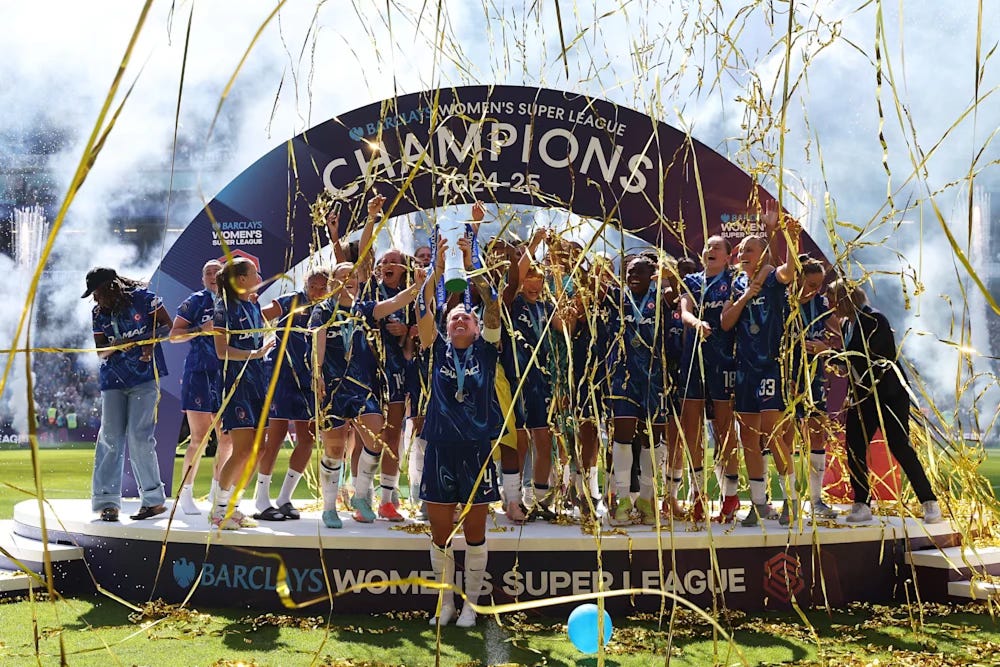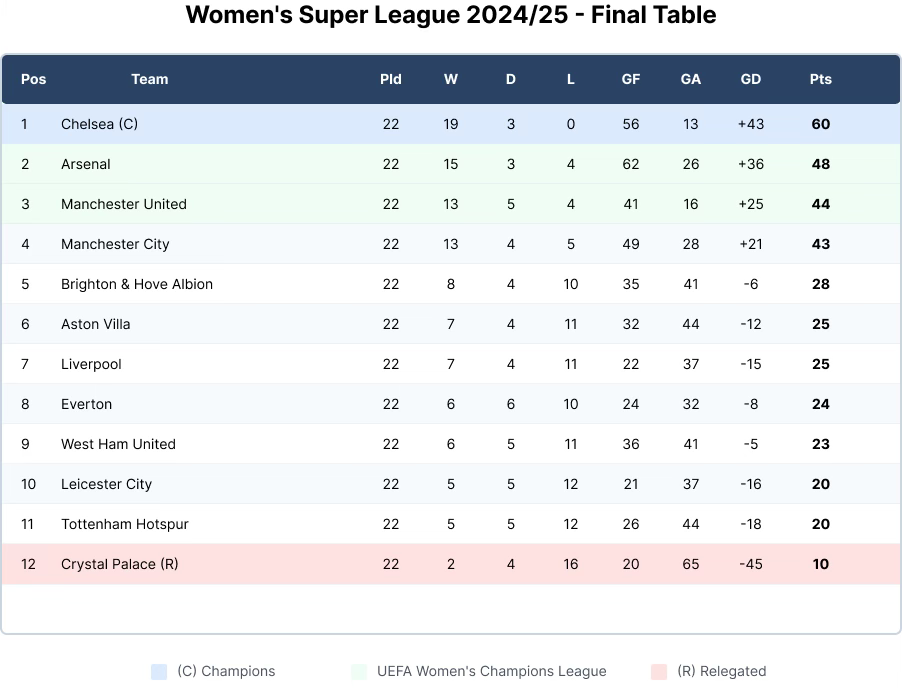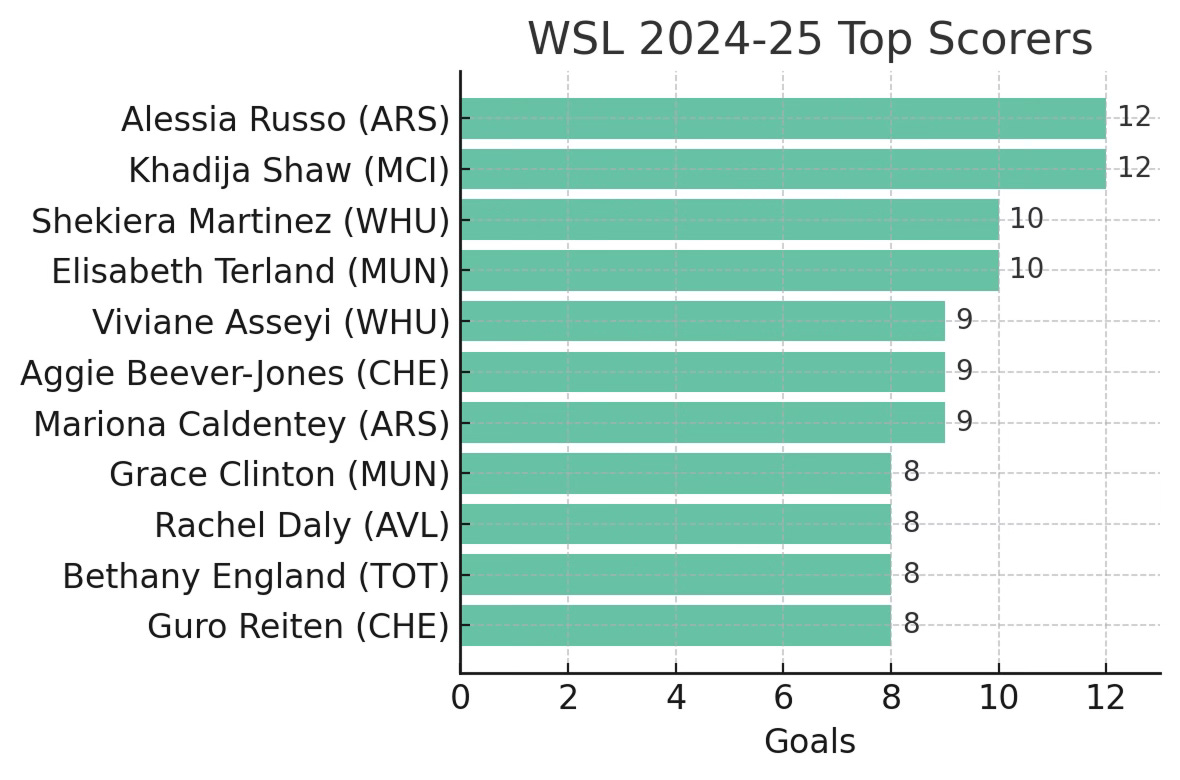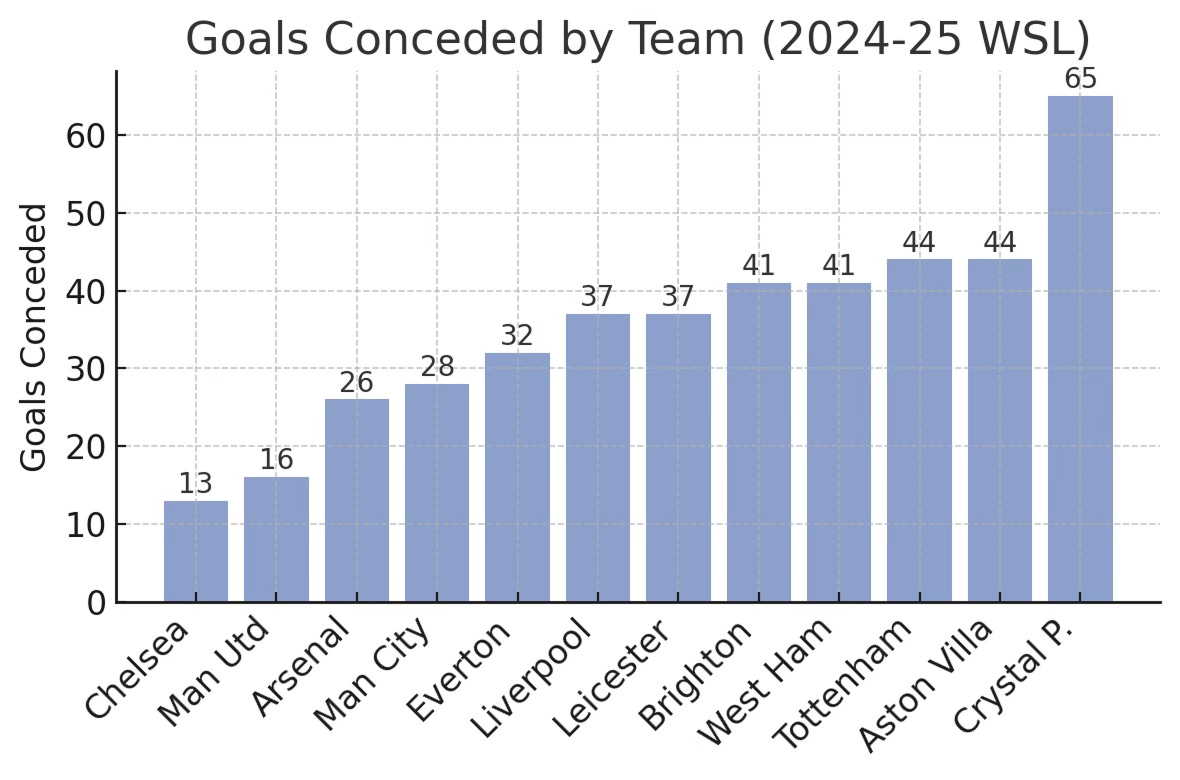2024–25 WSL End-of-Season Review: Chelsea’s Invincibles, Arsenal’s Surge, and a Shifting League Hierarchy
The full story of the 2024–25 WSL season: Chelsea’s record run, Arsenal’s surge, and the stats behind an increasingly stratified, possession-driven, and fiercely contested league.
Overview
The 2024-25 Barclays Women's Super League witnessed Chelsea crowned champions for the sixth consecutive season, completing a historic unbeaten campaign. Under new manager Sonia Bompastor, Chelsea recorded an impressive 19 wins and 3 draws with zero losses, accumulating 60 points – a WSL record points tally. They became the first team to go unbeaten in a 22-match season, finishing 12 points clear of Arsenal, who secured second place on the final day by beating Manchester United 4-3.
Manchester United claimed third place, while Manchester City fell to fourth, missing out on Champions League qualification after a trophyless season marked by key injuries. At the other end of the table, newly-promoted Crystal Palace struggled and were relegated after just one season, managing only 10 points.
Top Four vs the Rest: The Growing Gap
The 2024–25 WSL season made one thing unmistakably clear: a sharp divide now exists between the league’s top four—Chelsea, Arsenal, Manchester City, and Manchester United—and the bottom eight. The gap in quality, consistency, and squad depth translated into domination on the pitch.
Fortress Four: Almost Untouchable
Across the season, the top four clubs lost just four times in total to teams outside their elite circle. Chelsea were completely unbeaten, while Arsenal, United and City dropped just a handful of games each. Upsets were exceptionally rare, highlighting the growing stratification within the league.
Only Four Upsets All Season
In 64 matches between top-four and bottom-eight sides, only four ended in true shock wins for the underdogs:
Everton 2–1 Man City (Dec 15) – Everton’s first ever WSL win against City.
Aston Villa 5–2 Arsenal (Apr 27) – Villa’s biggest-ever WSL win.
Brighton 4–2 Arsenal (May 5) – Brighton’s first WSL win over the Gunners.
Liverpool 3–1 Man United (Mar 14) – Played in front of nearly 15,600 fans at Anfield.
Arsenal suffered two of these four defeats, the only top-four side to lose multiple times to bottom-half teams.
Big Teams at Home: A Locked Door
When bottom-eight clubs travelled to top-four stadiums, they earned just 4 points from a possible 96 (4.2% return):
Everton held Arsenal to a 0–0 draw at Emirates Stadium.
West Ham drew 2–2 with Chelsea at Kingsmeadow.
Aston Villa held Man United 0–0 at Leigh Sports Village.
Everton again drew 1–1 with Man City away.
That’s 4 points from 32 away games—a damning indicator of how hard it is for mid-to-lower-tier sides to lay a glove on the elite, especially away from home.
Notable Streaks and Surges
Chelsea's Invincibility
Chelsea's unbeaten run was the story of the season, though they often had to grind out results – ten of their 19 victories came by a single-goal margin. They trailed just four times all year and repeatedly struck late, with 17 of their 56 goals (30 %) arriving in the final 15 minutes — including eight in stoppage time.
Other Team Streaks
Arsenal: Had a turbulent start (6th place in October) before rebounding under new manager Renée Slegers to secure second
Aston Villa: Pulled off a dramatic late escape – winless in early spring, they won their last five games and climbed from 11th in March to 6th by season's end
West Ham: Were on course for a higher finish but lost their final two matches to slip to 9th
Brighton: Achieved a club-best 5th place under manager Dario Vidosic
Tottenham Hotspur: Endured a disappointing year (11th place) after an FA Cup final appearance last season – plagued by defensive frailty and a lack of creativity
Leicester City: Struggled for goals amid attacking injuries
Crystal Palace: Faced slim odds of survival with heavy defeats to top sides and an inability to hold leads, conceding a league-high 65 goals
Scoring and Offensive Metrics
Top Scorers
Arsenal's Alessia Russo and Man City's Khadija "Bunny" Shaw each tallied 12 goals, sharing the WSL Golden Boot. Russo was a constant threat as Arsenal's focal point – she led the league in touches in the opposition box (149) and was caught offside 26 times, showing how frequently she stretched defenses.
Shaw's 12 goals came in just 14 appearances, highlighting her clinical finishing when fit. Close behind the top two were West Ham's rising star Shekiera Martinez and Man United's Elisabeth Terland with 10 goals each.
Martinez in particular was an xG over-performer – her 10 goals came from only ~5.5 expected goals, the biggest +4.5 goal vs xG differential in the league. Despite joining West Ham in January, the 23-year-old averaged a goal or assist per 90 minutes and even netted four goals in one match (a 7-1 win over Crystal Palace).
A trio of players scored 9 goals: Viviane Asseyi (West Ham), Aggie Beever-Jones (Chelsea), and Mariona Caldentey (Arsenal) – notably, Caldentey also provided 5 assists in an impressive debut WSL season.
Highest Scoring Team
Arsenal led the league with 62 goals, comfortably ahead of Chelsea’s 56, thanks to a multi-pronged front line — six different Gunners hit at least five goals. They were especially ruthless in big wins, finishing 14.1 goals above their expected total, the widest xG over-performance in the league.
The WSL as a whole produced 424 goals from an expected 376, a +48 goal differential suggesting elevated attacking efficiency across the division. Only two teams — Liverpool and Crystal Palace — failed to meet their xG totals, while every other club outperformed expectation to some extent.
Least Scoring Teams
Crystal Palace finished as the WSL’s lowest scorers with just 20 goals, struggling to consistently convert chances at the top level. Leicester City followed with 21 goals, their campaign hampered by attacking injuries and low shot volume.
Liverpool scored 22 goals — third fewest in the league — and underperformed their expected goals by 3.1, the largest negative xG differential. Their finishing woes were underlined by a league-worst big-chance conversion rate of just 31.3%.
By contrast, Aston Villa (59.4%) and West Ham (48.8%) were the most clinical sides when it came to finishing clear-cut chances.
Shot Volume and xG Creation
Manchester City led the league in attacking pressure, averaging about 19.2 shots per game – the highest of any team. City dominated possession, often pinning teams back and racking up chances. However, their finishing did not keep pace early in the season, and injuries to star forwards like Shaw and Lauren Hemp saw their goal output (49) lag behind Arsenal's.
According to expected goals models, Chelsea generated the highest xG per game (2.19) in the league, slightly ahead of Arsenal and Man City. At the other end, Crystal Palace produced the lowest xG (≈0.98 per game), struggling to create quality chances in most matches.
Creativity, Possession, and Passing
Top Assist Providers
The playmaking leaderboard was topped by two Manchester City attackers:
Lauren Hemp: Recorded 8 assists (in only 10 appearances before injury)
Mary Fowler: Had 7 assists, stepping up creatively in Hemp's absence during the run-in
Two players tallied 6 assists each: Celin Bizet (Man Utd winger) and Viviane Asseyi (West Ham). A large group of players registered 5 assists, including Arsenal's Mariona Caldentey, Katie McCabe and Kim Little, among others.
Notably, no one reached double-digit assists; chance creation was fairly distributed across the top teams.
Possession and Passing Accuracy
Manchester City once again lived up to their reputation as a possession-dominant side, averaging a league-high 64.9% possession and completing 85.5% of their passes — both the best marks in the WSL. Despite this control, they occasionally struggled to translate dominance into goals.
Arsenal followed closely with 62.5% possession and 83.9% pass accuracy, using technical quality and midfield control to consistently outplay opponents. Chelsea ranked third in both metrics, averaging 59.3% possession and completing 81.6% of passes, reflecting their adaptable and efficient style under Sonia Bompastor.
Most mid-table teams hovered between 45–53% possession and completed around 76–79% of passes, but there was a steep drop toward the bottom. Leicester City (36.5%) and Crystal Palace (40.5%) averaged the lowest possession figures in the league and had the lowest pass completion rates at 71.4% and 71.5%, respectively — highlighting the technical and tactical gap between them and the league’s elite.
Creativity and Key Passes
Manchester United’s Grace Clinton led the league with eight successful through-balls, showcasing her vision and composure under pressure. As a team, United ranked second in through-balls (24), trailing only Chelsea (27).
Similarly, Arsenal’s Katie McCabe topped the WSL with 51 key passes, blending progressive runs with precise early deliveries from wide areas. Arsenal as a team also ranked second for key passes (290), just behind Chelsea’s league-leading 308.
Brighton’s attack flourished thanks to experienced additions: Fran Kirby contributed 7 goals and a stream of incisive passes, while Kiko Seike added 6 goals and 4 assists — including a memorable debut hat-trick against Everton.
On the flip side, Tottenham’s creative edge dulled following the departures of Grace Clinton and Celin Bizet, their two most productive creators in 2023–24. Spurs fell into the bottom half for both key passes and progressive passing metrics, a clear sign of their creative downturn.
Defensive Performance and Key Stats
Goals Conceded
Chelsea’s defense was every bit as dominant as their attack – they conceded just 13 goals in 22 matches, by far the fewest in the WSL. Their solidity was anchored by new goalkeeper Hannah Hampton and a disciplined, compact back line that stayed composed even under sustained pressure.
Manchester United were next-best defensively, conceding only 16 goals, a testament to Marc Skinner’s aggressive pressing structure and organised defensive phases.
On xGA (expected goals against), Arsenal were actually the strongest — they allowed just 20.5 xGA total, or 0.93 per match, the lowest in the league. However, a few high-scoring defeats inflated their actual goals conceded to 26, with nearly half (12 goals) coming in their final three matches. Whether due to fatigue, focus shifting to the Champions League final, or a drop in defensive intensity, their end-of-season wobble masked what had been a statistically elite defensive campaign.
The defensive gap between the top four and the rest was clear: all four conceded fewer than 30 goals, with xGA averages under 1.5, while every other side shipped 32+ goals and finished with a negative goal difference.
Clean Sheets & Goalkeeping
The Golden Glove was shared by Chelsea’s Hannah Hampton and Manchester United’s Phallon Tullis-Joyce, each recording 13 clean sheets in 22 matches. Hampton seamlessly replaced Ann-Katrin Berger and was pivotal in Chelsea’s record-setting defensive season.
Tullis-Joyce, in her debut WSL campaign, faced significantly more shots than Hampton and emerged as a standout signing — the American recorded a league-best +6.8 goals prevented, meaning she saved nearly seven more goals than expected based on shot quality (post-shot xG).
Daphne van Domselaar also impressed for Arsenal, keeping 10 clean sheets in just 15 appearances and boasting the second-best mark in the league for goals-against-per-90 (0.67).
At Manchester City, 20-year-old Khiara Keating made 12 appearances, keeping 4 clean sheets with a 56.1% save rate after stepping up during an injury-hit campaign.
Further down the table, Courtney Brosnan was Everton’s undisputed standout. She produced +6.5 goals prevented— the second-best mark in the league — despite facing 122 shots on target, also the second-highest total. Brosnan’s five clean sheets were hard-earned behind a porous back line, and her consistent shot-stopping kept Everton competitive in several matches. If the Golden Glove were awarded for overall goalkeeping impact, not just clean sheets, Brosnan would be a serious contender.
Defensive Actions
Tottenham's veteran full-back Ashleigh Neville stood out individually despite her team's woes. She led the league with 73 tackles won and also made the most interceptions (44) of any player, epitomising her all-action style.
In midfield, Man City's Yui Hasegawa excelled at regaining possession – she made 174 recoveries, the most of any player, while astonishingly committing 0 fouls in over 1,935 minutes as a holding midfielder.
Aerially, Liverpool’s Sophie Román Haug was unmatched in volume — she won 88 of 140 aerial duels, both league highs in raw numbers.
Key Takeaways and Trends
Chelsea's Invincibles
Chelsea's undefeated title run firmly establishes them as the WSL's modern dynasty. They set records for points (60) and wins, and their eighth WSL title overall (sixth straight) came despite the transition to a new manager.
The team showed championship pedigree in close games, often finding a goal when needed. Bompastor's squad proved they could handle adversity – from late winners to absorbing pressure with 10 players behind the ball – making them deserved champions.
Chelsea's dominance was also psychological: rivals know that even if they manage to hold them for 80+ minutes, the Blues can strike late (over 30% of Chelsea's goals came after the 75th minute).
Rising Competitive Bar at the Top
Arsenal, Manchester United, and Manchester City all had strong campaigns but were left ruing missed opportunities.
Arsenal boasted the WSL’s most explosive attack (62 goals) and reached the Champions League final, but a slow league start and a defensive collapse in the final weeks prevented them from seriously challenging Chelsea.
Manchester United returned to the top three for the second time in three seasons, built on defensive solidity (16 GA) and impressive adaptation to squad changes. They maintained an aggressive high press and were dangerous from set-pieces throughout.
Manchester City, widely tipped to win the title, started strong but lost momentum after winter. Injuries to Lauren Hemp and Bunny Shaw disrupted their rhythm and contributed to a late drop-off that saw them finish fourth.
The fact that all three have pushed Chelsea at different points in recent seasons shows the growing competitiveness at the top — but Chelsea’s ability to stay consistent under pressure remains the decisive factor.
Mid-Table Movements
The middle of the table saw considerable volatility and late-season drama:
Brighton climbed to 5th, up from 9th last season, with summer signings like Fran Kirby and Kiko Seike boosting their attacking threat.
West Ham finished 9th up from 11th last season. The second half of their campaign was far more competitive — powered by breakout striker Shekiera Martinez, they posted their best attacking metrics in years.
Aston Villa were deep in the relegation battle as late as March, but a stunning turnaround under new manager Natalia Arroyo — including five wins from their final five games — propelled them to 6th.
Liverpool endured a turbulent season that included a mid-season managerial change, while Everton were destabilised by an off-pitch ownership saga that overshadowed on-pitch progress.
Relegation Battle
The fight to avoid the lone relegation spot centred on Aston Villa, Everton, Tottenham and Leicester, with West Ham briefly dragged in during the winter, until Villa’s late surge (five straight wins) pulled them well clear.
In the end, it was newly promoted Crystal Palace whose inexperience proved costly. They finished with both the worst attack (20 goals) and worst defense (65 conceded) in the league — a combination that left little room for survival.
Palace’s relegation was confirmed with two games to spare following a 7–1 loss to West Ham, and they ended the season 10 points adrift at the bottom.
They will be replaced in 2025–26 by London City Lionesses, who clinched the Women’s Championship title on the final day to make history as the first fully independent club to earn promotion.
League Trends
Increasing Goals: The WSL is seeing increasing goal totals – 3.21 goals per game (424 total) — up from 2.80 last season and 2.48 the year before.
Outperforming xG: Many teams outperformed expected goals, suggesting either improving finishing quality or perhaps goalkeepers underperforming league-wide. The division out-scored expected goals by +48; ten of twelve clubs beat their xG.
Defensive Improvement: The top teams' defenses are getting better – the best backlines are conceding under 0.7 goals per game. Chelsea again set the standard, conceding just 0.59 goals per match — the league’s best figure since their own 0.45 GA/Match in 2020-21 — while Manchester United followed at 0.73.
Tactical Evolution: Mid-table sides such as Brighton, Aston Villa, and West Ham raised their possession shares and PPDA, mirroring the big clubs’ tactical blueprint.
Conclusion
The 2024-25 WSL campaign underlined Chelsea’s dominance yet again, while the chasing pack edged closer. An historic unbeaten title run from the champions, breakout seasons for rising stars, and a genuinely competitive scrap through the mid-table and relegation zones all showcased the league’s accelerating quality and excitement.
With a full season of data to pore over, every club will return sharper and better informed. The bar to catch Chelsea—and to climb the WSL hierarchy—has never been higher, setting the stage for an even more data-driven and fiercely contested 2025-26 season.
Sources
Team and player statistics from official WSL feeds, Opta/FBref data; additional narrative and context from BBC Sport, Reuters, and ESPN reporting. All figures refer to the 2024-25 WSL season only, with cup competitions excluded to keep the focus on league performance.
👋 Stay Connected
Enjoyed this review?
If you want weekly WSL insights, stat deep dives, and match previews, subscribe and share! We’d also love to hear your thoughts — reply or comment below 💬Follow @WSLAnalytics on X for bite-sized stats and updates.





